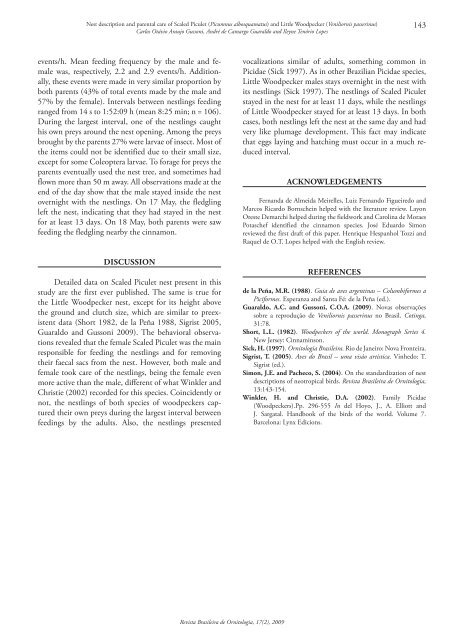art01 - omena júnior.indd - Sociedade Brasileira de Ornitologia
art01 - omena júnior.indd - Sociedade Brasileira de Ornitologia
art01 - omena júnior.indd - Sociedade Brasileira de Ornitologia
- No tags were found...
Create successful ePaper yourself
Turn your PDF publications into a flip-book with our unique Google optimized e-Paper software.
Nest <strong>de</strong>scription and parental care of Scaled Piculet (Picumnus albosquamatus) and Little Woodpecker (Veniliornis passerinus)Carlos Otávio Araujo Gussoni, André <strong>de</strong> Camargo Guaraldo and Ileyne Tenório Lopes143events/h. Mean feeding frequency by the male and femalewas, respectively, 2.2 and 2.9 events/h. Additionally,these events were ma<strong>de</strong> in very similar proportion byboth parents (43% of total events ma<strong>de</strong> by the male and57% by the female). Intervals between nestlings feedingranged from 14 s to 1:52:09 h (mean 8:25 min; n = 106).During the largest interval, one of the nestlings caughthis own preys around the nest opening. Among the preysbrought by the parents 27% were larvae of insect. Most ofthe items could not be i<strong>de</strong>ntified due to their small size,except for some Coleoptera larvae. To forage for preys theparents eventually used the nest tree, and sometimes hadflown more than 50 m away. All observations ma<strong>de</strong> at theend of the day show that the male stayed insi<strong>de</strong> the nestovernight with the nestlings. On 17 May, the fledglingleft the nest, indicating that they had stayed in the nestfor at least 13 days. On 18 May, both parents were sawfeeding the fledgling nearby the cinnamon.DISCuSSIONDetailed data on Scaled Piculet nest present in thisstudy are the first ever published. The same is true forthe Little Woodpecker nest, except for its height abovethe ground and clutch size, which are similar to preexistentdata (Short 1982, <strong>de</strong> la Peña 1988, Sigrist 2005,Guaraldo and Gussoni 2009). The behavioral observationsrevealed that the female Scaled Piculet was the mainresponsible for feeding the nestlings and for removingtheir faecal sacs from the nest. However, both male andfemale took care of the nestlings, being the female evenmore active than the male, different of what Winkler andChristie (2002) recor<strong>de</strong>d for this species. Coinci<strong>de</strong>ntly ornot, the nestlings of both species of woodpeckers capturedtheir own preys during the largest interval betweenfeedings by the adults. Also, the nestlings presentedvocalizations similar of adults, something common inPicidae (Sick 1997). As in other Brazilian Picidae species,Little Woodpecker males stays overnight in the nest withits nestlings (Sick 1997). The nestlings of Scaled Piculetstayed in the nest for at least 11 days, while the nestlingsof Little Woodpecker stayed for at least 13 days. In bothcases, both nestlings left the nest at the same day and hadvery like plumage <strong>de</strong>velopment. This fact may indicatethat eggs laying and hatching must occur in a much reducedinterval.ACKNOWLeDGemeNTSFernanda <strong>de</strong> Almeida Meirelles, Luiz Fernando Figueiredo andMarcos Ricardo Bornschein helped with the literature review. LayonOreste Demarchi helped during the fieldwork and Carolina <strong>de</strong> MoraesPotaschef i<strong>de</strong>ntified the cinnamon species. José Eduardo Simonreviewed the first draft of this paper. Henrique Hespanhol Tozzi andRaquel <strong>de</strong> O.T. Lopes helped with the English review.RefereNCes<strong>de</strong> la Peña, M.R. (1988). Guia <strong>de</strong> aves argentinas – Columbiformes aPiciformes. Esperanza and Santa Fé: <strong>de</strong> la Peña (ed.).Guaraldo, A.C. and Gussoni, C.O.A. (2009). Novas observaçõessobre a reprodução <strong>de</strong> Veniliornis passerinus no Brasil. Cotinga,31:78.Short, L.L. (1982). Woodpeckers of the world. Monograph Series 4.New Jersey: Cinnaminson.Sick, H. (1997). <strong>Ornitologia</strong> <strong>Brasileira</strong>. Rio <strong>de</strong> Janeiro: Nova Fronteira.Sigrist, T. (2005). Aves do Brasil – uma visão artística. Vinhedo: T.Sigrist (ed.).Simon, J.E. and Pacheco, S. (2004). On the standardization of nest<strong>de</strong>scriptions of neotropical birds. Revista <strong>Brasileira</strong> <strong>de</strong> <strong>Ornitologia</strong>,13:143‐154.Winkler, H. and Christie, D.A. (2002). Family Picidae(Woodpeckers).Pp. 296‐555 In <strong>de</strong>l Hoyo, J., A. Elliott andJ. Sargatal. Handbook of the birds of the world. Volume 7.Barcelona: Lynx Edicions.Revista <strong>Brasileira</strong> <strong>de</strong> <strong>Ornitologia</strong>, 17(2), 2009
















